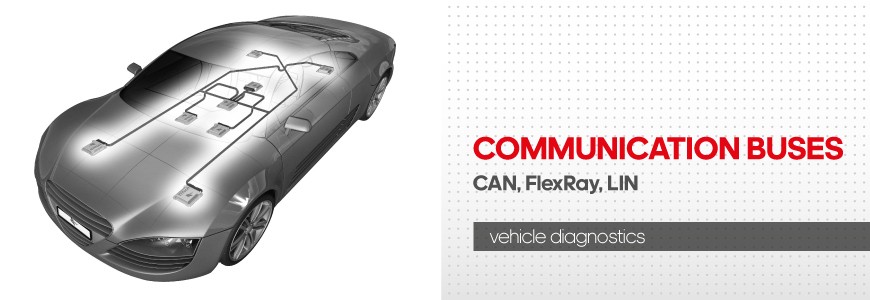
Many vehicles nowadays are equipped with multiple electronic control units, even those belonging to a budget segment. Implementation of the majority of engineering solutions has become possible due to the use of high-performance electronic components which require data exchange. The data are transmitted in the form of synchronized signals via special buses: FlexRay, CAN, and LIN.
CAN (Controller Area Network) bus
CAN is the first standard protocol of data exchange between vehicle electronic control units. Today, the CAN bus is widely used in all types of road transport, as well as in factory automation systems.
СAN specifics:
- Differential signaling.
- Each message or frame uses a digital identifier that provides a message priority for arbitration.
- A well-designed error processing scheme that implies a re-transmission of a message in case of its improper receipt.
- Efficient mechanisms of error detection and defective nodes removal from the bus.
Advantages:
- Possibility of real-time operation.
- Low cost.
- Wide range of operating speeds.
- A large variety of products from different suppliers.
Disadvantages:
- The data exchange rate of 1 Mbit/s (usually up to 500 Kbit/s) is not sufficient for the active safety of modern vehicles.
- Only 8 bytes data can be transmitted through a single CAN Bus message
- A large size of service information in a packet compared to the size of the data payload.
- One bad ECU may paralyze the whole operation of the CAN network.
FlexRay bus
FlexRay is a successor of a CAN bus. Higher data rates and bigger size of transmitted data make a basic difference between the two buses. FlexRay is used in safety-critical and adaptive cruise control systems of luxury cars.
FlexRay specifics:
- Differential signaling.
- Time-triggered communications eliminate the need for prioritizing messages.
- Each ECU itself examines the received data packet for correctness.
Advantages:
- Possibility of real-time operation.
- High data rates – up to 10 Mbit/s.
- The configurable payload length is up to a maximum of 256 bytes.
- A malfunction of some ECU does not affect the network reliability and uninterrupted communication with other ECUs.
Disadvantages:
- High cost and considerable expenses on the development of new nodes. It requires the use of special transceivers and controllers that can support the high time accuracy of data delivery.
- The maximum bus length is limited by a low signal rate.
LIN bus
A LIN bus is used in such vehicle systems where the rate of data exchange is of no importance: sensors and executive mechanisms of climate systems, windshield wipers, window lifters, drive gears, rearview mirror heating, headlights, etc.)
LIN specifics
- Single-wire data transmission line.
- Consists of a single master and up to 16 slave nodes.
Advantages:
- Failure of some individual components does not affect an uninterrupted operation of the other network components.
- Low cost of the components, easy implementation.
Disadvantages:
- Low data exchange rate – up to 20Kbit/s.
MSG Equipment develops and manufactures diagnostic equipment for vehicles operating under different communication protocols:
- Controller MS561 and specialized cables: diagnostics of steering racks with CAN and FlexRay.
- Tester MS016: reading and saving data via the LIN bus.
- Other MSG Equipment test benches and testers: controlling automotive alternators via the LIN bus.
Find more information on the equipment that works with different vehicle communication buses on servicems.eu.



COMMENTS